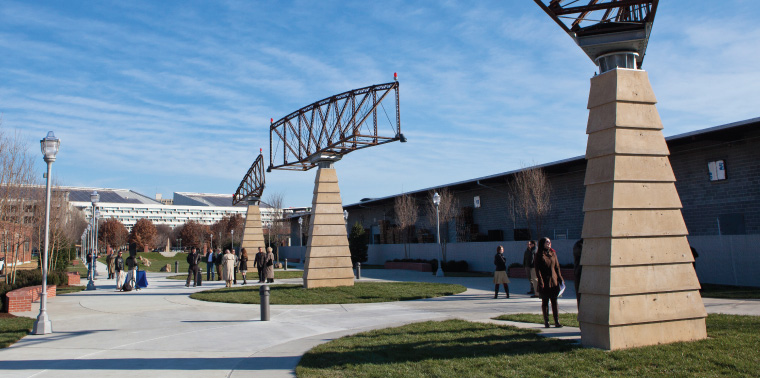May 13, 2013 — Residents on the south side of Chattanooga, Tenn., celebrated the new year with a new playground meant for adults. Main Terrain, a park situated on an abandoned railroad lot, features a running track, cross-training equipment and interactive sculptures.
The park is a welcome patch of green space in a neighborhood transitioning from light industrial to a mixed-use community of retail, residences and industry, says Mike Fowler, a principal of Ross/Fowler Architecture and Landscape Architecture, the firm that consulted with the city on designing the space. “It is an intensely paved environment, and Main Terrain is a green respite.”
The park offers respite of a less visible sort to Chattanooga’s stormwater management system. Beneath the lush turf is a mix of topsoil, sand and gravel, specially designed to filter stormwater runoff. After a heavy rain, two retention ponds in the park hang onto runoff for eight to 10 hours; a system of drain tiles moves the rainwater to a nearby underground storage tank, where it ultimately serves as irrigation water for the park.
Stormwater management is one of those vital necessities of the built environment that remain invisible unless it fails.
Main Terrain is one of a growing number of urban developments that mix stormwater management with recreational facilities. A rail yard in Milwaukee has been redeveloped as a mixed-use industrial park with picnic areas, athletic fields and a stormwater system that filters pollutants out of runoff. In Neu Ulm, Germany, a public plaza designed by landscape architecture firm Atelier Dreiseitl uses a filtration device and public fountains to sequester urban runoff from the main stormwater system. And the Qunli Stormwater Park, a project in Haerbin City, China, won last year’s Award of Excellence from the American Society of Landscape Architects. One of the driving forces among all of these experiments is a radical rethinking of how we manage urban runoff.
Sea Change for Stormwater
For many of us, our interest in stormwater management began and ended around age 10, when we would put on swimsuits, run out into the rain and race pinecones down the street until they disappeared into the maw of a cast-iron sewer drain. But the fact is that stormwater management is one of those vital necessities of the built environment that remain invisible unless it fails, causing damaging floods to low-lying neighborhoods.
For most U.S. cities, those cast-iron openings along the curb represented the primary method of stormwater management when they were constructed: Rain fell on the roofs and pavement of the city, ran downhill to the nearest gutter, coursed into the underground sewer system, and dumped into the nearest body of water.
The idea was to “get it the hell away from here as fast as possible,” says Thomas Ballestero, director of the University of New Hampshire Stormwater Center in Durham. That strategy worked pretty well for the “here” — by preventing urban floods — but not so well for the “there.” Every storm dumped litter and pollutants into the watershed, and the volume of water concentrated from even small rainstorms caused erosion downstream. Worse, many municipal systems combined stormwater and human waste in one sewer system. Rainstorms would overcome those systems and wash raw sewage into the watershed.
The Clean Water Act was designed to correct these shortcomings. In its latest incarnation, the federal legislation requires municipalities and new developments to incorporate more nuanced forms of managing stormwater.
These new strategies include a wide range of possibilities, according to Reid Christianson, a water resources engineer for the Center for Watershed Protection, a Maryland-based nonprofit organization that helps municipalities design and site stormwater treatment facilities. Some strategies, such as rain barrel and rain garden programs, prevent runoff in the first place. Others, such as the retention ponds at Main Terrain, use green space to hold runoff long enough to allow the soil to absorb the pollutants it contains.
In dense urban areas, green space can be hard to come by — hence the drive behind mixed-use projects like Main Terrain. Originally, Chattanooga’s department of public works had proposed the entire Main Terrain site be used as a holding pond for stormwater runoff. “We heard a strong voice from the community in favor of green space that incorporates fitness and art,” Fowler says. “A simple retention basin would have consumed the entire site, and people wouldn’t have been able to use it for recreation at all.”
Partial Solution
Just how effective are projects like Main Terrain at keeping pollutants out of the watershed? “The most accurate answer is that it hasn’t been studied enough,” says Jonathan Scott, communications director for the nonprofit organization Clean Water Action. “These projects are coming online rapidly, and they barely have enough funding for the project itself, much less the science.”
As a general rule, Scott says, the more a wastewater system looks like nature, the more successful it is likely to be. Hence, a retention pond, which uses the natural process of soil infiltration to purify standing water, is a better choice than a simple culvert running into a nearby stream. But Scott cautions against simple solutions to a complex problem. “A retention pond is better than nothing at all, but it’s still only a Band-Aid,” he says. “Better than that is a plan that doesn’t look at one site, but looks at the community as a whole and deploys a variety of strategies — from semipermeable pavement, to grassy swales, to nonpaved areas and natural species — all those things working together.”
Even if stormwater retention projects do a good job of keeping pollutants out of our watersheds, the soil that filters runoff doesn’t fare quite so well. “Soil has a high affinity to hold onto pollutants; that’s the point,” says Christianson. “But at some point, you have to remove that soil, and if it’s really hot — if it’s really full of pollution — that’s an issue. You’ve created a brownfield that needs remediation.”
“If we’re able to use, say, 50,000 gallons of irrigation water, then that’s 50,000 gallons we don’t have to treat at the water treatment plant.”
That level of contamination could take up to 100 years, says Ballestero, but cultural practices, like littering or seal-coating driveways, increase the toxicity of soils in retention projects. “If people are doing these things all over the watershed, that stuff will collect in the water. If you don’t put it in there in the first place, it’s much cheaper than the cure. But we’re reluctant to change our cultural practices.”
Variety of Benefits
In Chattanooga, the rainwater filtration and storage system at Main Terrain is one small piece of the complicated puzzle that makes up the city’s stormwater system — but it provides a variety of benefits. For one thing, the irrigation system takes water out of the sewer system altogether, says Chris Davis of Volkert, Inc., who served as the civil engineer on the project. “If we’re able to use, say, 50,000 gallons of irrigation water, then that’s 50,000 gallons we don’t have to treat at the water treatment plant.”
The system also allows a more controlled flow of rainwater into the sewer system. The underground cistern that collects the filtered rainwater from Main Terrain’s retention pond is controlled by a valve that keeps a computerized eye on the forecast. When rain is coming, it lets some of the 40,000 gallons of water in the cistern flow out into the main sewer system, spreading the impact of any storm over a period of days.
A more nuanced impact of projects like Main Terrain, according to Ballestero, is simply bringing attention to the issue of stormwater. “It helps raise public awareness,” he says. “At a demonstration project, the public can see it and kick the tires. They start to understand how they’re improving the water quality, and that’s vital.”
In fact, that kind of cultural awareness may be the most important impact of all. By rendering visible the normally unseen world of stormwater management, projects like Main Terrain might begin to nudge us in the direction of more careful attention to our water resources — before they run down the drain. ![]()
Ensia shares solutions-focused stories free of charge through our online magazine and partner media. That means audiences around the world have ready access to stories that can — and do — help them shape a better future. If you value our work, please show your support today.
Yes, I'll support Ensia!
